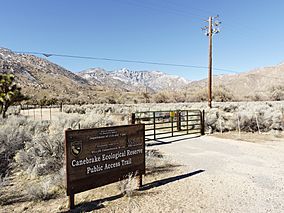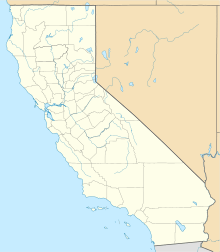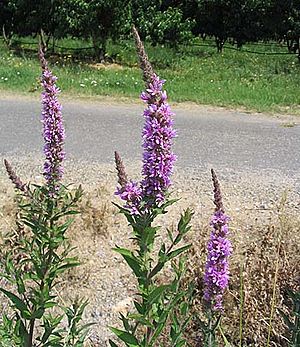Canebrake Ecological Reserve facts for kids
Quick facts for kids Canebrake Ecological Reserve |
|
|---|---|
|
IUCN Category Ia (Strict Nature Reserve)
|
|

Access gate along SR 178
|
|
| Location | Kern County, California |
| Nearest city | Ridgecrest |
| Area | 6,700 acres (27 km2) |
| Established | 1996 |
| Governing body | California Department of Fish and Game |
Canebrake Ecological Reserve is a special nature area in Kern County, California. It covers about 6,700 acres (27 square kilometers) and is located in the beautiful Southern Sierra Nevada mountains. This reserve helps protect important wildlife and their homes.
The South Fork Valley, where the reserve is, was one of the first areas settled around 1846. People described it as a "fertile strip of bottomland." The first land bought for the reserve was part of the old Bloomfield Ranch.
Contents
About Canebrake Ecological Reserve
The California Department of Fish and Game bought the land for the reserve in 1994. By 1996, about 1,300 acres (5.3 square kilometers) became the Canebrake Reserve. It is named after Canebrake Creek, which flows into the South Fork Kern River.
You can explore the reserve on a 1.2-mile (1.9 km) nature trail. This trail is even wheelchair accessible! Along the trail, you can see a forest of cottonwood and willow trees. You might also spot some unique Joshua trees growing there.
How the Reserve Grew
The reserve became bigger in 2002 and 2005 with more land purchases. These new areas, like Cap Canyon and Scodie Canyon, are important. They act like natural bridges, helping wildlife move safely between the reserve and Sequoia National Forest.
Money for the 2005 land purchase came from Proposition 117. This was a special law passed in California in 1990. It created a fund to help protect natural habitats and wildlife across the state.
Rare Birds of Canebrake
Canebrake Ecological Reserve is a very important place for many bird species. Some of these birds are quite rare.
You might find the southwestern willow flycatcher here. This bird is listed as an endangered species by the government. The reserve is home to one of the largest groups of these flycatchers in the United States.
Other rare birds include the western yellow-billed cuckoo and the tricolored blackbird. These birds are also considered endangered or of special concern in California.
The Kern red-winged blackbird is another special bird found here. Sadly, some of its historic nesting areas were lost. In 1954, when Lake Isabella was filled, it covered many miles of the birds' nesting spots. Even so, the South Fork Valley still has the largest group of these blackbirds, with up to 500 individuals. They nest from the Canebrake Ecological Reserve all the way to Lake Isabella.
Helping Nature: Habitat Restoration
People at the reserve work hard to restore the habitat. This means they help bring the natural environment back to a healthy state.
One important part of restoration is planting new trees. They plant Fremont cottonwood, red willow, and California black walnut trees. The goal is to create more dense forests for birds like the Kern red-winged blackbird and the southwestern willow flycatcher. These birds need thick cottonwood-willow forests to live and raise their young.
Another big part of the work is removing harmful invasive species. These are plants that are not native to the area and can take over, hurting the local plants and animals. Examples include tamarisk trees and purple loose-strife.
From 1987 to 1993, about 340 acres (1.4 square kilometers) were replanted with Fremont cottonwood and red willow trees. These trees were planted in areas that had been cleared for farming. More than 90 percent of these new trees have survived, which is great news for the wildlife!



